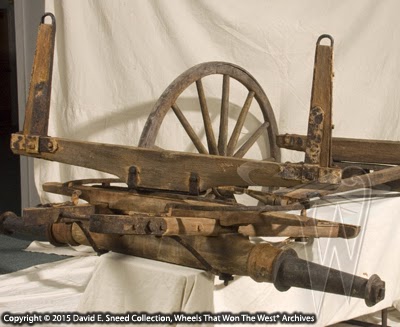Not long ago Ireceived a question from a friend asking if there were ever design variationsor different construction styles of a Peter Schuttler brand wagon hub. It’s a great question and one that someenthusiasts may not be aware of. Beyondthe obvious variations in different hub sizes, there indeed were subtle, butnotable differences in certain aspects of Schuttler designs over thedecades. Believe it or not, there wereeven major color shifts in some Schuttler running gears.
A while back,during one of my research trips out of state, I happened across a Peter Schuttlerbrand wagon with a ‘yellow’ gear. It hadbeen sloppily overpainted orange but the original color, striping, andstenciling could still be seen in several areas. The initial color of the gear had clearly been yellow with black striping andstenciling. While there were a number ofearly builders that were known for producing yellow running gears, Schuttler isnot one that usually comes to mind – even to knowledgeable collectors. Orange was the gear color seen on virtuallyevery Peter Schuttler wagon from the company’s beginnings in 1843. It’s astatement reinforced through period literature as well as an extremely raresurvivor located at the Steamboat Arabia Museum in Kansas City, Missouri. Keptin a climate-controlled enclosure, this set of wheels represents the earliestsurviving Schuttler and one we were the first to extensively study, photograph,and identify back in May of 2007.
 |
| We were given exclusive access and the opportunity tothoroughly document this 1856 Peter Schuttler running gear in 2007. |
I wrote afollow-up article on the discovery later that year and it was published by TheCarriage Journal in January 2008. Wealso posted a variation of the story on our website at the time. Alongwith several tons of miscellaneous supplies and goods, the spanking-new wagongear was originally loaded on board the Steamboat Arabia. The journey was short-lived as the entire shipsank on the Missouri River not long after leaving Westport (Kansas City) in1856. Today, at well over 150 years inage, it is likely to be the oldest surviving factory-built wagon inAmerica. We were graciously provided extraordinaryaccess to the vehicle at the time; allowing us to document various technologiespresent as well as dimensions, colors, construction features, and survivingmarkings. In the process of the review,we found a number of remnants of orange paint pigment on the wagon. Our Archivesalso hold 1870’s, ‘80’s and ‘90’s-era color advertising from the company. Combined with the gear found on the SteamboatArabia, the surviving evidence seems to confirm the regular and consistent useof orange paint on Peter Schuttler running gears throughout the 19th century.
For a company tobe so aligned with a particular hue, the use of a different color like yellow canbe indicative of some type of change within the firm. Sometimes, these changes are identifiers ofdifferent types of vehicles or even a preference indicated by an end user orretailer. In this case, the gear hadother variations as well, leading us to feel reasonably confident that the yellowcoloring is likely tied to the transition of the company’s assets from Chicagoto Springfield, Missouri during the mid-1920’s. Close examination of the wagon revealed a numberof additional design elements consistent with transitional vehicles builtduring early ownership by the Springfield Wagon Company.
Why is thisinformation important? For the veryreasons our Wheels That Won The West® Archives exist as a historical resource,this knowledge helps us to better identify, authenticate, date, and provide supportableprovenance to vintage pieces. Withoutthese background details, a wagon is just a wagon with no personality toseparate it from a sea of non-descript designs. Ultimately, every stick of timber, every contour, every bit of iron, andevery part of the paint hold clues… Clues that bring us closer to fullyunderstanding America’s early wagons and western vehicle builders.
Thanks forstopping by today. By the way, if you haven’t signed up to receive this weekly blog via e-mail, just type your address in the "Follow By E-mail" section above. You'll receive a confirmation e-mail that you'll need to verify before you're officially on board. Once that's done, you'll receive an email every time we update the blog. Please don't hesitate to let us know if we can be of assistance. We appreciate yourcontinued feedback and look forward to sharing even more wooden vehicle info inthe coming weeks.
Please Note: As with each of our blog writings, all imagery and text is copyrighted with All Rights Reserved. The material may not be broadcast, published, rewritten, or redistributed without prior written permission from David E. Sneed, Wheels That Won The West® Archives.